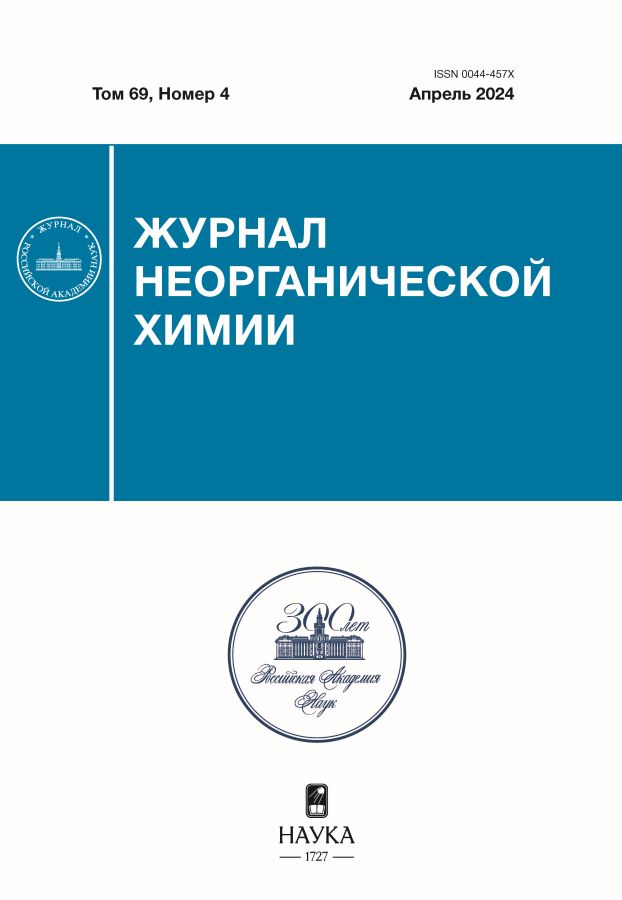Stability of Supramolecular β-Cyclodextrin-Pyrene Complexes in A Silicate Hydrogel Matrix
- Authors: Kondakova A.V.1, Medvedeva A.A.1, Koshkin A.V.1
-
Affiliations:
- Center of Photochemistry of the Russian Academy of Sciences
- Issue: Vol 69, No 4 (2024)
- Pages: 567-572
- Section: НЕОРГАНИЧЕСКИЕ МАТЕРИАЛЫ И НАНОМАТЕРИАЛЫ
- URL: https://rjraap.com/0044-457X/article/view/666573
- DOI: https://doi.org/10.31857/S0044457X24040122
- EDN: https://elibrary.ru/ZXSNCU
- ID: 666573
Cite item
Abstract
In order to use the β-cyclodextrin-pyrene complex as a fluorescent receptor center, its stability in the solid phase of a water-soluble silicate gel was investigated. For this purpose, a technique for obtaining a silicate matrix with a high content of supramolecular complexes was developed and the temperature stability of the resulting material was investigated. Optimal conditions for working with complexes in the silica gel matrix have been identified. Comparative studies of the fluorescence spectra of complexes in liquid and solid phases were carried out by the method of fluorescence spectroscopy. As a result of the work done, it was possible to determine the main patterns of behavior of the supramolecular complex in the silicate hydrogel matrix and to conclude about the influence of the matrix structure on its stability.
Full Text
About the authors
A. V. Kondakova
Center of Photochemistry of the Russian Academy of Sciences
Author for correspondence.
Email: anv.kond@yandex.ru
Russian Federation, Moscow, 119421
A. A. Medvedeva
Center of Photochemistry of the Russian Academy of Sciences
Email: anv.kond@yandex.ru
Russian Federation, Moscow, 119421
A. V. Koshkin
Center of Photochemistry of the Russian Academy of Sciences
Email: anv.kond@yandex.ru
Russian Federation, Moscow, 119421
References
- Odinokov A., Alfimov M. // Chem. Phys. Lett. 2017. V. 667. P. 108. https://doi.org/10.1016/j.cplett.2016.11.054
- Yan H., He L., Zhao W. et al. // Anal. Chem. 2014. V. 86. № 22. P. 11440. https://doi.org/10.1021/ac503546r
- Xie Y., Wang N., Li Y. et al. // Anal. Chim. Acta. 2019. V. 1088. P. 137. https://doi.org/10.1016/j.aca.2019.08.059
- Avakyan V.G., Nazarov V.B., Koshkin A.V. et al. // High. Energy Chem. 2015. V. 49. № 3. P. 177. https://doi.org/10.1134/S0018143915030030
- Avakyan V.G., Nazarov V.B., Odinokov A.V. et al. // J. Lumin. 2016. V. 180. P. 328. https://doi.org/10.1016/j.jlumin.2016.08.051
- Ogoshi T., Harada A. // Sensors. 2008. V. 8. № 8. P. 4961. https://doi.org/10.3390/s8084961
- Oborina E.N., Adamovich S.N. // Russ. J. Gen. Chem. 2021. V. 91. № 12. P. 2424. https://doi.org/10.1134/S1070363221120100
- Bender M.L., Komiyama M. Cyclodextrin Chem. Berlin, Heidelberg: Springer Berlin, Heidelberg, 1978. https://doi.org/10.1007/978-3-642-66842-5
- Dong D.C., Winnik M.A. // Photochem. Photobiol. 1982. V. 35. № 1. P. 17. https://doi.org/10.1111/j.1751-1097.1982.tb03805.x
- Nakajima A. // Bull. Chem. Soc. Jpn. 1971. V. 44. № 12. P. 3272. https://doi.org/10.1246/bcsj.44.3272
- Matsui K. // Langmuir. 1992. V. 8. № 2. P. 673. https://doi.org/10.1021/la00038a061
- Matsui K., Tominaga M., Arai Y. et al. // J. Non-Cryst. Solids. 1994. V. 169. № 3. P. 295. ttps://doi.org/10.1016/0022-3093(94)90325-5
- Kaufman V.R., Avnir D. // Langmuir. 1986. V. 2. № 6. P. 717. https://doi.org/10.1021/la00072a008
- Kalyanasundaram K., Thomas J.K. // J. Am. Chem. Soc. 1977. V. 99. № 7. P. 2039. https://doi.org/10.1021/ja00449a004
- Гирсова М.А., Головина Г.Ф., Куриленко Л.Н. и др. // Физика и химия стекла. 2021. V. 47. № 4. P. 428. https://doi.org/10.31857/S0132665121040077
- Girsova M.A., Kurilenko L.N., Anfimova I.N. // Glass Phys. Chem. 2021. V. 47. № 1. P. 62. https://doi.org/10.1134/S1087659621010053
- Tegge G. // Starch – Stärke. 1982. V. 34. № 11. P. 395. https://doi.org/10.1002/star.19820341113
- Rekharsky M.V., Inoue Y. // Chem. Rev. 1998. V. 98. № 5. P. 1875. https://doi.org/10.1021/cr970015o
- Harata K. // ChemInform. 2010. V. 29. № 39. https://doi.org/10.1002/chin.199839315
- Saenger W., Jacob J., Gessler K. et al. // Chem. Rev. 1998. V. 98. № 5. P. 1787. https://doi.org/10.1021/cr9700181
- Medvedeva A., Dubinets N., Koshkin A. et al. // J. Mol. Liq. 2024. V. 393. P. 123651. https://doi.org/10.1016/j.molliq.2023.123651
- Ionova I.V., Medvedeva A.A., Koshkin A.V. et al. // J. Sol-Gel Sci. Technol. 2022. V. 101. № 2. P. 335. https://doi.org/10.1007/s10971-021-05696-7
- Koshkin A.V., Aleksandrova N.A., Ivanov D.A. // J. Sol-Gel Sci. Technol. 2017. V. 81. № 1. P. 303. https://doi.org/10.1007/s10971-016-4183-0
- Munoz de la Pena A., Ndou T.T., Zung J.B. et al. // J. Am. Chem. Soc. 1991. V. 113. № 5. P. 1572. https://doi.org/10.1021/ja00005a019
- Nelson Gregory., Patonay Gabor., Warner I.M. // Anal. Chem. 1988. V. 60. № 3. P. 274. https://doi.org/10.1021/ac00154a018
- Messner M., Kurkov S.V., Palazón M.M. et al. // Int. J. Pharm. 2011. V. 419. № 1–2. P. 322. https://doi.org/10.1016/j.ijpharm.2011.07.041
- Connors K.A. // Chem Rev. 1997. V. 97. № 5. P. 1325. https://doi.org/10.1021/cr960371r
- Айлер Р.К. // Химия кремнезема: растворимость, полимеризация, коллоидные и поверхностные свойства, биохимия. М.: Мир, 1982. https://books.google.ru/books?id=Dc0RAQAAIAAJ (accessed October 16, 2023).
- Yamanaka T., Takahashi Y., Kitamura T. et al. // J. Lumin. 1991. V. 48–49. P. 265. https://doi.org/10.1016/0022-2313(91)90119-G
- Barashkov N.N., Sakhno T.V., Nurmukhametov R.N. et al. // Russ. Chem. Rev. 1993. V. 62. № 6. P. 539. https://doi.org/10.1070/RC1993v062n06ABEH000032
Supplementary files
















